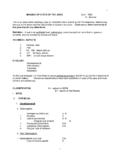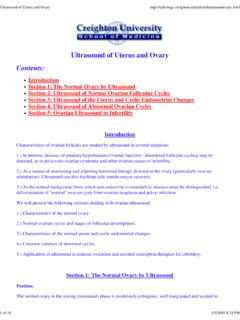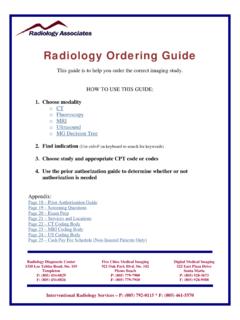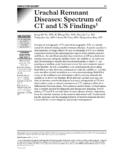Transcription of THE RADIOLOGY OF THE MAXILLARY SINUS - …
1 1 THE RADIOLOGY OF THE MAXILLARY SINUS . Neill Serman. Aug. 2000. I. INTRODUCTION. In dental radiographs of the MAXILLARY posterior teeth, portions of the image of the MAXILLARY SINUS often appear. Also, the dentist is often consulted with the problem of differential diagnoses of apparent odontalgia and disturbances in the MAXILLARY SINUS . Knowledge of the MAXILLARY SINUS falls within the sphere of the dentist. II. TECHNICAL PROCEDURES. 1. Pantomogram. 2. 15 degrees (Postero-anterior MAXILLARY SINUS ; Waters) 3. Occlusal - posterior 60 degrees. 4. Lateral SINUS . 5. Tomograms. 6. CT - for bone and MRI - for soft tissue lesions. III. ANATOMY OF THE MAXILLARY SINUS . 1. Is the largest of the paranasal sinuses 2.
2 Development begins in utero at 3 months as an evagination of the epithelium of the lateral wall of the nasal fossa 3. At birth is the size of a pea 4. Enlarges after eruption of deciduous and again with permanent teeth. 5. Shape - vaguely pyramidal with the base formed by the infra-temporal wall of the maxilla; the roof by the floor of the orbit. 6. The floor is very thin and the apex of the second premolar and molar teeth may appear to project into the SINUS . 7. The medial wall is also the lateral wall of the nose. 8. Anterior border usually lies apical to or over the root of canine. 9. Distal border often extends into tuberosity. 10. Great variation in size of sinuses - also left and right sides 11. Pneumatization occurs with extraction of teeth. 12.
3 Allergy, trauma etc. can affect the growth. 13. Projection effect. Overlapping of periodontal ligament space may appear as increased periapical radiolucency suggestive of periapical infection. 14. The image of the body of the zygomatic bone and the temporal process of the zygomatic bone may be superimposed on the SINUS on a radiograph - less with paralleling technique. 15. Radiographically just posterior to the posterior wall of the SINUS one may see a tear- drop radiolucency - the pterigomaxillary fissure. 16. In certain projections the inferior and middle turbinate bones may appear medially superimposed on the SINUS . 17. MAXILLARY tori may appear as pathological radiopacities in the SINUS but below the image of the hard palate. 218. The angle at which the radiograph is taken may make the roots appear to project further into the SINUS .
4 The roots usually lie buccally to the SINUS and are separated from the SINUS by a thin plate of bone. 19. May have septa that separate SINUS into compartments 20. Communicates, via aperture [os] 3-6mm in diameter, with posterior aspect of middle turbinate. 21. On occlusal radiographs the nasolacrymal duct may appear to superimpose on the SINUS . 22. The depression above the alveolar ridge is known as the alveolar recess; that extending into the zygomatic arch, the zygomatic recess. IV. PRECAUTIONARY MEASURES WITH RADIOGRAPHIC INTERPRETATION. 1. As the sinuses are often not the same size they must not be compared 2. Overlapping of upper lip may present radiopacity and be interpreted as chronic infection of the mucosa of the SINUS 3. Similarly overlapping of ala of nose may appear as a polyp or cyst of the SINUS 4.
5 The petrous part of sphenoid may overlap with SINUS and appear as a thickening of MAXILLARY mucosal lining. 5. Lateral wall (base of pyramid) appears more radiopaque than the other outlines of the SINUS . 6. The medial wall of the SINUS is very thin and due to angle of radiograph it may not be seen and may be mistaken for bone destruction. 7. The groove of the posterior superior alveolar artery may appear as linear radiolucency and be interpreted as a fracture of the wall of the SINUS . 8. The dorsum of the tongue may appear as a fluid level or a thickening on the floor of the SINUS . V. PATHOLOGY OF THE MAXILLARY SINUS . A. NON DENTAL SINUSITIS. Due to infection or allergic reaction. In acute stage the os from the SINUS to the nasal cavity, may close producing severe pain but no change on the radiograph.
6 Radiographically may appear normal. Chronic sinusitis may be seen either due to thickening of the mucosal lining as linear radiopacities vaguely following the outline of the SINUS floor or as fluid levels with the upper margin always horizontal immaterial of the head position. B. SINUSITIS OF DENTAL OR PERIODONTAL ORIGIN i. There may or may not be a periapical reaction with loss of vitality. ii. With a periapical reaction of teeth adjacent to the SINUS , there is destruction of the periapical lamina dura and bone adjacent to the SINUS . Seen as a poorly or well defined, round, periapical radiolucency iii. In some cases the periosteum may be elevated superiorly thus depositing a layer of new bone which appears as a thin radiopaque opacity bulging into the floor of the SINUS known as the halo effect, 3iv.
7 Or the organisms may penetrate the SINUS and produce a localized thickening [radiopacity] of the antral mucosa known as a mucositis. v. When the cause of the mucositis is a tooth it is usually localized but if due to advanced periodontal disease the floor of the antrum thickens and no halo formation occurs. vi. Such a mucositis is often asymptomatic and will return to normal after treatment, will no longer be seen radiographically. C. CYSTIC CONDITIONS. 1. Extrinsic cysts develop outside SINUS but encroach upon it. a. A thin sclerotic border usually delineates the cyst from the rest of the SINUS . b. May occupy the entire SINUS and may be difficult to diagnose. Remember that the normal antrum has an undulating outline where-as a cyst will be more rounded c.
8 Odontogenic - radicular, kerato, dentigerous d. Neurogenic meningocele - neurogenic cystic condition. e. Surgical ciliated cyst - follows surgical procedure - sometimes after many years. Is an implantation cyst 2. Intrinsic cysts. These are not true cysts as they are not epithelial lined. a. Mucous retention cyst - due to obstruction of duct of minor seromucinous gland b. Serous retention cyst - inflammatory in origin. Consists of loculated fluid in the mucoperiosteum and thus has no epithelial lining c. Mucocele due to gradually expanding collection of fluid within the SINUS initiated by the obstruction of the ostium. Rare in MAXILLARY SINUS . a and b generally also referred to as mucocele. Radiographically : The SINUS may be partially or totally opaque with thinning of the intact walls.
9 [With a malignancy the wall will be destroyed]. One is not able to distinguish these "cysts" radiologically. Usually seen as a dome shaped opacity on the floor of the SINUS . D. TRAUMA AND THE MAXILLARY SINUS . 1. Various MAXILLARY fractures involve the nose and SINUS . 42. During exodontia a fracture of the floor of the SINUS may occur and may result in an oro-antral fistula. 3. There may be a prolapse of the SINUS lining into the oral cavity. With a soft ray this may be seen as a soft tissue shadow. Often seen clinically. 4. The oro-antral fistula radiographically may resemble a malignancy as there is a loss of continuity ofthe SINUS floor. History important. 5. Blow to the orbit may produce a blow-out fracture in floor of orbit. Tomographs of great help in diagnosis 6.
10 Radiographically : Perhaps the most constant findings with trauma is the complete opacification/cloudiness of the SINUS due to hemorrhage. Also loss of continuity of outline. Diff Diagnosis : mucocele; malignancy; fibrous dysplasia E. ROOT APEX IN SINUS 1. May appear to be in SINUS due to superimposition. Look for lamina dura to distinguish. 2. Tooth may be under mucosal lining where the taking of X-rays with the head tilted will not allow movement of the root 3. Position of tooth on radiograph will vary if head placed in different position if recently pushed into SINUS 4. If root remains it soon becomes attached to lining due to granulation tissue formation - no movement 5. May act as nidus for deposition of calcium salts producing antroliths F.

















